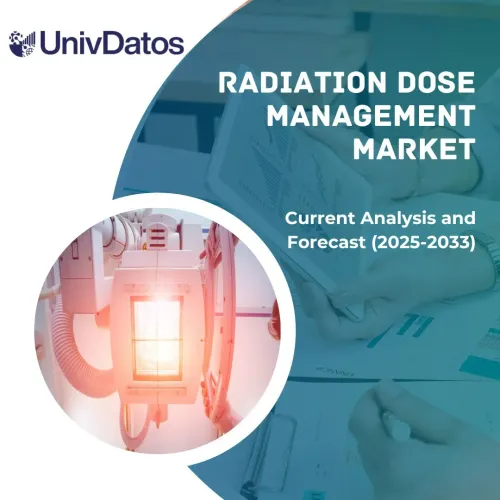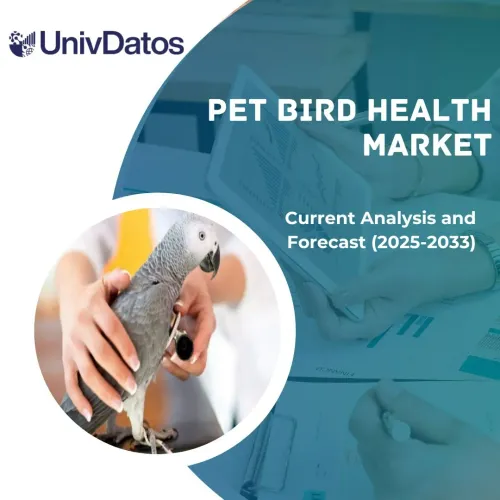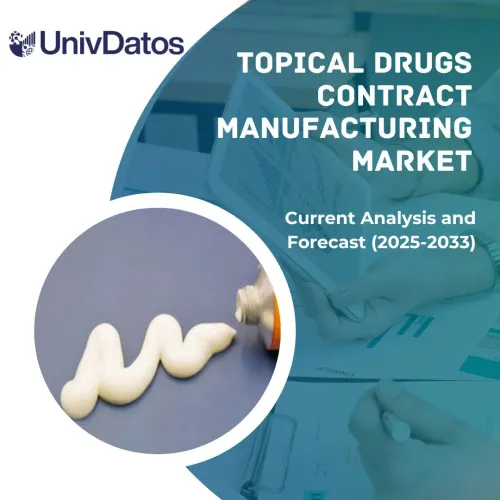- Home
- About Us
- Industry
- Services
- Reading
- Contact Us
Diagnostic Enzymes Market: Current Analysis and Forecast (2022-2028)
Emphasis on Type (Taq Polymerase, RNase Inhibitors, Cas9 Enzyme, Acid Phosphatase, Glucose Oxidase/Glucose Dehydrogenase, Urease, Lactate Oxidase, and Others); Application (Infectious Diseases, Autoimmune Diseases, Oncology, Cardiology, Nephrology, Diabetes, and Others); Product Type (Molecular Enzymes and Clinical Enzymes); End Users (Hospitals, Clinical Laboratories, and Others) and Region/Country
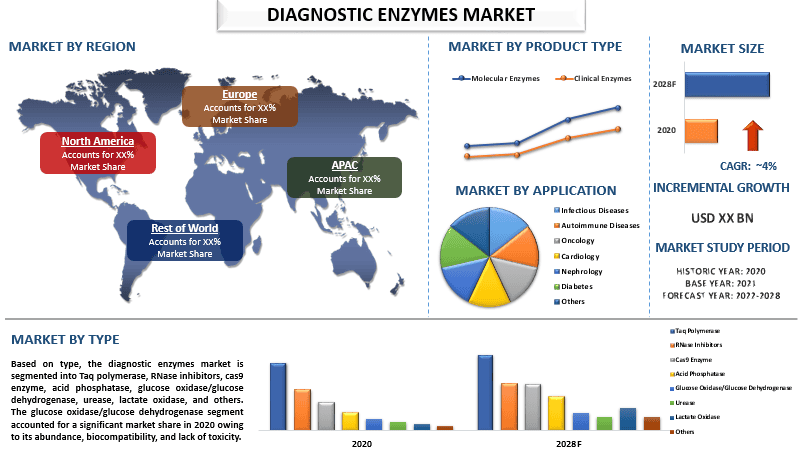
Global Diagnostic Enzymes Market is expected to grow at a significant rate of around 4% during the forecast period. Diagnostic enzymes are used to detect, diagnose, or forecast the development of disease conditions. They can be used alone or as a component of an assay system to identify the presence or absence of a variety of substances. Due to their substrate selectivity and quantifiable activity when other proteins are present, these enzymes are employed in diagnostics. In the market for enzyme diagnostics, machine learning and artificial intelligence are slowly gaining appeal. When it comes to the catalysis of an enzyme’s reaction steps, machine learning and artificial intelligence (AI) assist businesses in the enzyme diagnostic market in conducting a thorough analysis of all pertinent data, offering insights into the function of enzymes and enabling doctors to comprehend the primary determinants of the relationship between protein structure, function, and evolution. For instance, businesses like BioMarker have poured money into artificial intelligence and machine learning for enzyme diagnostics. In June 2020, a co-marketing enzyme supply collaboration agreement for the production and co-marketing of enzymes for life science applications, including diagnostics, was announced by Codexis, Inc. and Alphazyme LLC., a US-based company in the development and manufacture of nucleic acid metabolizing enzymes.
Takara Bio, Inc., Promega Corporation, Enzo Life Sciences, Inc., Merck KGaA, Thermo Fisher Scientific, Inc., Creative Enzymes, F. Hoffmann-La Roche Ltd., Solis BioDyne, Ampliqon A/S, and Genzyme Corporation are some of the key players in the market. Several M&As along with partnerships have been undertaken by these players to facilitate customers with hi-tech and innovative products/technologies.
Insights Presented in the Report
“Amongst type, diagnostic enzymes category to witness significant market share during the forecast period”
Based on type, the diagnostic enzymes market is segmented into Taq polymerase, RNase inhibitors, cas9 enzyme, acid phosphatase, glucose oxidase/glucose dehydrogenase, urease, lactate oxidase, and others. The glucose oxidase/glucose dehydrogenase segment accounted for a significant market share in 2020 owing to its several advantages such as its abundance, biocompatibility, and lack of toxicity. Furthermore, the entry of global players into emerging markets adds to the growth of the market during the forecast period.
“Amongst application, the infectious diseases to hold a significant share in the market in 2020”
On the basis of application, the diagnostic enzymes market is segmented into infectious diseases, autoimmune diseases, oncology, cardiology, nephrology, diabetes, and others. Among these, the infectious diseases segment to hold a significant share of the market in 2020. This is mainly due to the rising incidence of infectious diseases, that require early detection using these enzymes. For instance, according to the CDC/National Center for Health Statistics, 2022, the number of emergency department visits with infectious and parasitic diseases as the primary diagnosis in the US was 3.4 million. Therefore, infectious diseases such as typical pneumonia, TB, streptococcal pharyngitis, ulcerative urogenital infections, and a number of chronic conditions can be easily diagnosed with enzyme-based techniques like PCR.
“North America to hold a significant share in the market”
In 2020, North America held a significant share of the global diagnostic enzymes market. This is mainly due to the increased need for enzymes and the rising incidence of infectious diseases in the region which has become dominant. In order to combat the continuing epidemic, the FDA has approved COVID-19 laboratory-developed diagnostics for emergency use. The majority of these emergency usage authorizations also make use of RT-PCR-based testing and enzyme-linked immunosorbent assays for the identification of SARS-CoV-2. The creation of such tests is anticipated to be profitable in the North American market because of the high usage of enzymes during RT-PCR.
Reasons to buy this report:
- The study includes market sizing and forecasting analysis validated by authenticated key industry experts.
- The report presents a quick review of overall industry performance at one glance.
- The report covers an in-depth analysis of prominent industry peers with a primary focus on key business financials, product portfolio, expansion strategies, and recent developments.
- Detailed examination of drivers, restraints, key trends, and opportunities prevailing in the industry.
- The study comprehensively covers the market across different segments.
- Deep dive regional level analysis of the industry.
Customization Options:
The global diagnostic enzymes market can further be customized as per the requirement or any other market segment. Besides this, UMI understands that you may have your own business needs, hence feel free to connect with us to get a report that completely suits your requirements.
Table of Content
Research Methodology for the Diagnostic Enzymes Market Analysis (2022-2028)
Analyzing the historical market, estimating the current market, and forecasting the future market of the global diagnostic enzymes market were the three major steps undertaken to create and analyze the adoption of diagnostic enzymes in major regions globally. Exhaustive secondary research was conducted to collect the historical market numbers and estimate the current market size. Secondly, to validate these insights, numerous findings and assumptions were taken into consideration. Moreover, exhaustive primary interviews were also conducted, with industry experts across the value chain of the global diagnostic enzymes market. Post assumption and validation of market numbers through primary interviews, we employed a top-down/bottom-up approach to forecasting the complete market size. Thereafter, market breakdown and data triangulation methods were adopted to estimate and analyze the market size of segments and sub-segments of the industry pertains to. Detailed methodology is explained below:
Analysis of Historical Market Size
Step 1: In-Depth Study of Secondary Sources:
Detail secondary study was conducted to obtain the historical market size of the diagnostic enzymes market through company internal sources such as annual reports & financial statements, performance presentations, press releases, etc., and external sources including journals, news & articles, government publications, competitor publications, sector reports, third-party database, and other credible publications.
Step 2: Market Segmentation:
After obtaining the historical market size of the diagnostic enzymes market, we conducted a detailed secondary analysis to gather historical market insights and share for different segments & sub-segments for major regions. Major segments are included in the report as type, application product type, and end users. Further country-level analyses were conducted to evaluate the overall adoption of testing models in that region.
Step 3: Factor Analysis:
After acquiring the historical market size of different segments and sub-segments, we conducted a detailed factor analysis to estimate the current market size of the diagnostic enzymes market. Further, we conducted factor analysis using dependent and independent variables such as type, application product type, and end users of diagnostic enzymes. A thorough analysis was conducted for demand and supply-side scenarios considering top partnerships, mergers and acquisitions, business expansion, and product launches in the diagnostic enzymes market sector across the globe.
Current Market Size Estimate & Forecast
Current Market Sizing: Based on actionable insights from the above 3 steps, we arrived at the current market size, key players in the global diagnostic enzymes market, and market shares of the segments. All the required percentage shares split, and market breakdowns were determined using the above-mentioned secondary approach and were verified through primary interviews.
Estimation & Forecasting: For market estimation and forecast, weights were assigned to different factors including drivers & trends, restraints, and opportunities available for the stakeholders. After analyzing these factors, relevant forecasting techniques i.e., the top-down/bottom-up approach were applied to arrive at the market forecast for 2028 for different segments and sub-segments across the major markets globally. The research methodology adopted to estimate the market size encompasses:
- The industry’s market size, in terms of revenue (USD) and the adoption rate of the diagnostic enzymes market across the major markets domestically
- All percentage shares, splits, and breakdowns of market segments and sub-segments
- Key players in the global diagnostic enzymes market in terms of products offered. Also, the growth strategies adopted by these players to compete in the fast-growing market
Market Size and Share Validation
Primary Research: In-depth interviews were conducted with the Key Opinion Leaders (KOLs) including Top Level Executives (CXO/VPs, Sales Head, Marketing Head, Operational Head, Regional Head, Country Head, etc.) across major regions. Primary research findings were then summarized, and statistical analysis was performed to prove the stated hypothesis. Inputs from primary research were consolidated with secondary findings, hence turning information into actionable insights.
Split of Primary Participants in Different Regions
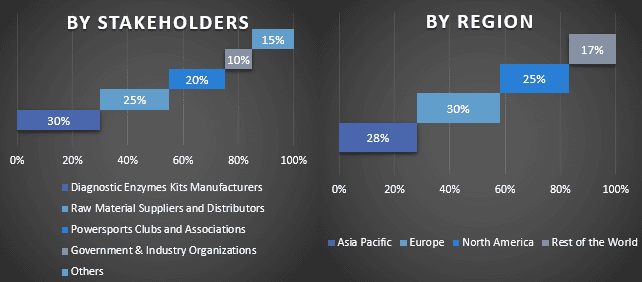
Market Engineering
The data triangulation technique was employed to complete the overall market estimation and to arrive at precise statistical numbers for each segment and sub-segment of the global diagnostic enzymes market. Data was split into several segments & sub-segments post studying various parameters and trends in the areas of type, application product type, and end users in the global diagnostic enzymes market.
The Main Objective of the Global Diagnostic Enzymes Market Study
The current & future market trends of the global diagnostic enzymes market were pinpointed in the study. Investors can gain strategic insights to base their discretion for investments on the qualitative and quantitative analysis performed in the study. Current and future market trends determined the overall attractiveness of the market at a regional level, providing a platform for the industrial participant to exploit the untapped market to benefit from a first-mover advantage. Other quantitative goals of the studies include:
- Analyze the current and forecast market size of the diagnostic enzymes market in terms of value (USD). Also, analyze the current and forecast market size of different segments and sub-segments
- Segments in the study include areas of type, application product type, and end users.
- Define and analysis of the regulatory framework for the diagnostic enzymes
- Analyze the value chain involved with the presence of various intermediaries, along with analyzing customer and competitor behaviors of the industry.
- Analyze the current and forecast market size of the diagnostic enzymes market for the major region.
- Major countries of regions studied in the report include Asia Pacific, Europe, North America, and the Rest of the World.
- Company profiles of the diagnostic enzymes market and the growth strategies adopted by the market players to sustain in the fast-growing market
- Deep dive regional level analysis of the industry
Related Reports
Customers who bought this item also bought

